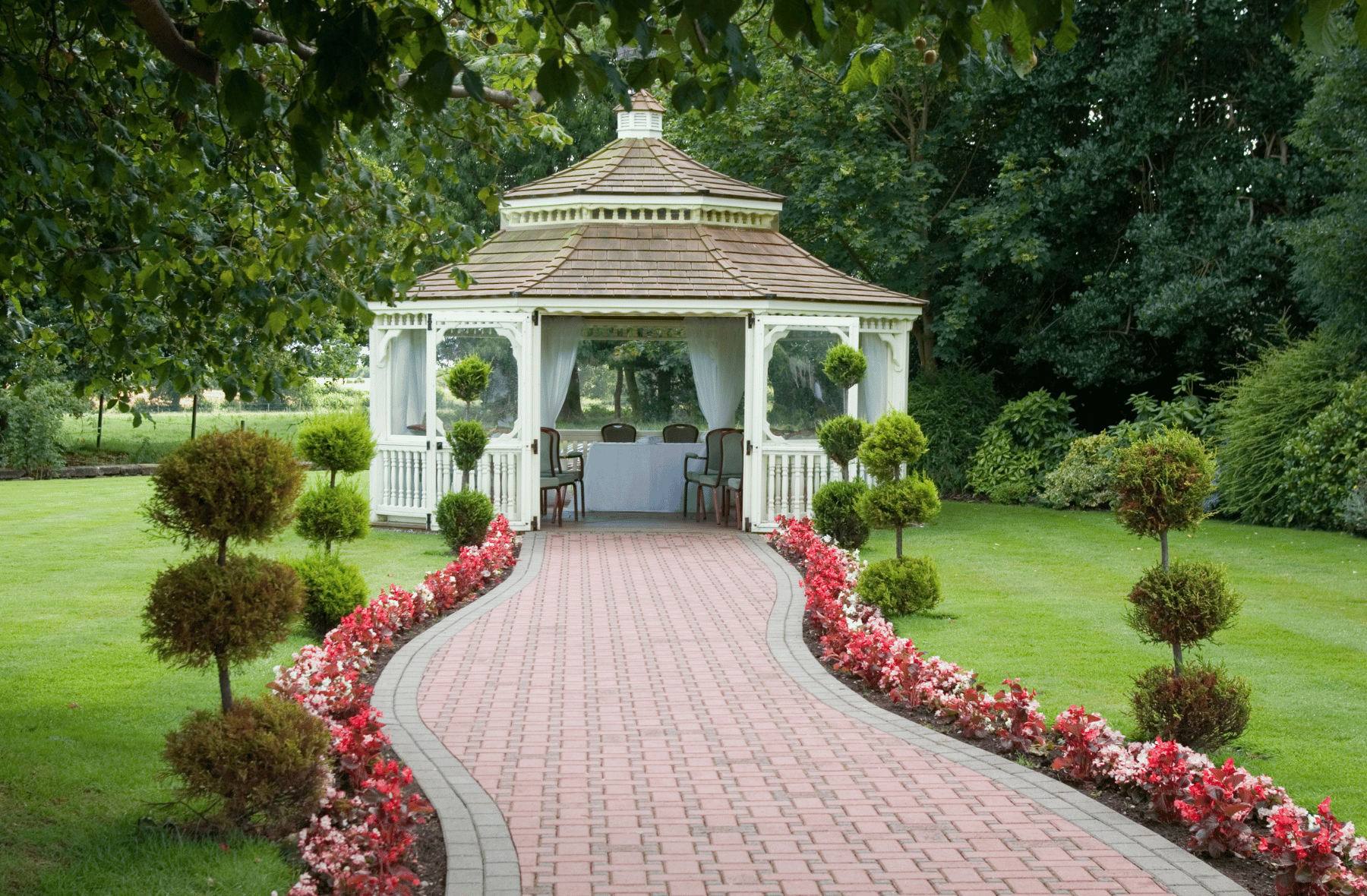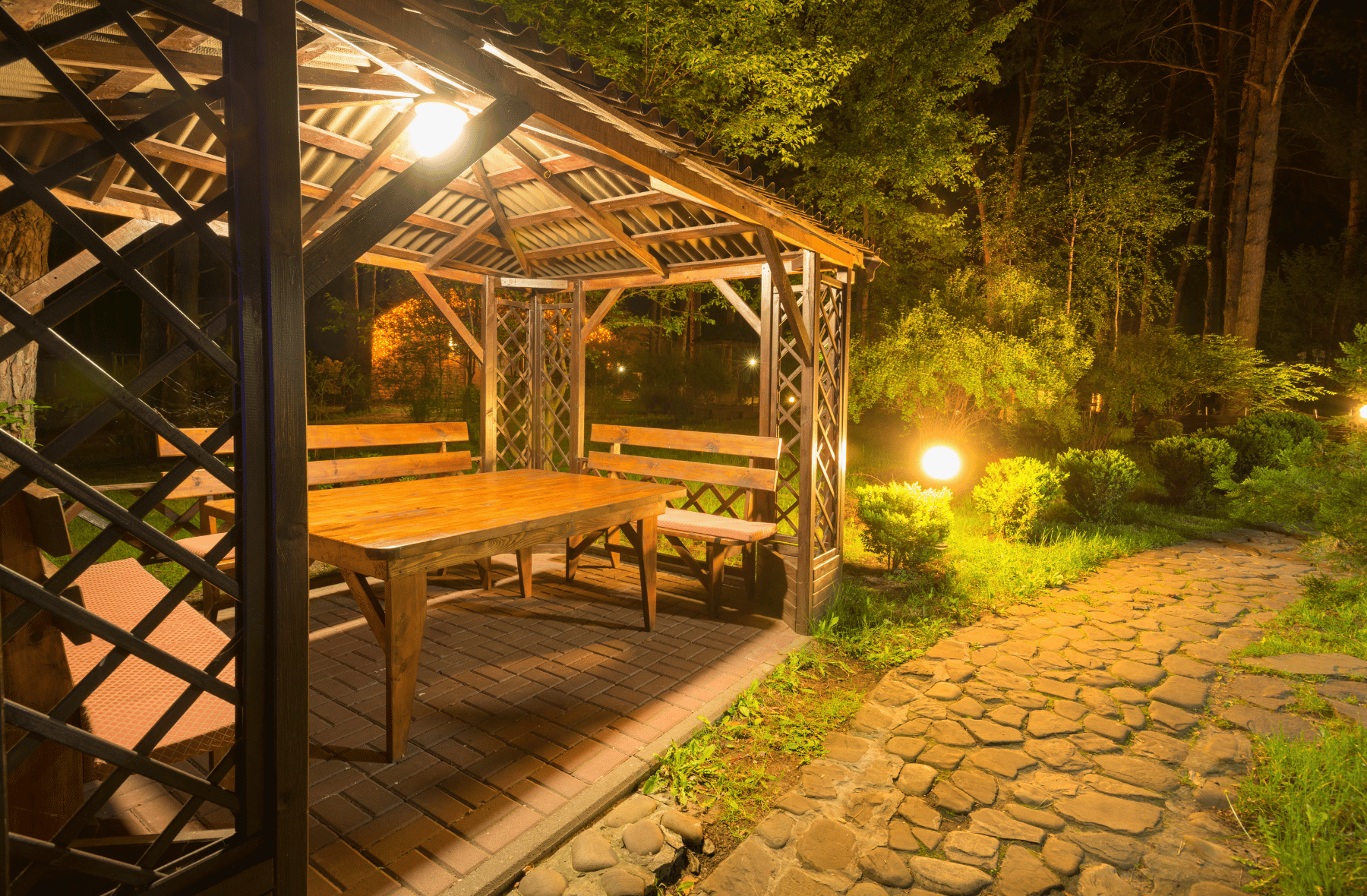The Evolution of Gazebos: An Historical Perspective

For centuries, gazebos have charmed people across cultures as versatile and visually striking garden structures.
They serve both functional and decorative purposes, providing a shaded sanctuary that integrates effortlessly into various landscapes. Whether used as a retreat, an event space, or a focal point, gazebos remain an enduring element of outdoor design.
By exploring their historical roots and understanding their modern-day benefits, homeowners can appreciate how gazebos enhance residential properties.
Ancient Beginnings
Gazebos trace their origins back thousands of years, with evidence of garden pavilions dating as far back as ancient Egypt. These early structures served as cool, shaded spaces to escape the sweltering heat while offering elevated views of the Nile River.
In ancient Persia, gazebos took on a symbolic role in the iconic “paradise gardens.” Known as kiosks, these structures featured ornate designs and colorful tile work. They were central to royal gardens, embodying ideals of beauty and tranquility.
Greek and Roman Influence
In ancient Greece, open-air pavilions and temples were built to honor the gods and provided public spaces for reflection. The Romans refined this concept, creating pleasure pavilions adorned with classical columns and intricate stonework. These elegant structures symbolised wealth and were often the centerpiece of elaborate estates.
The Middle Ages and the Renaissance
During the Middle Ages, gazebos became more private, serving as quiet spaces in monasteries and abbeys. The Renaissance ushered in a golden era for gazebos in Europe. Wealthy families in countries like Italy, France, and England constructed them as decorative focal points in sprawling gardens. Renaissance gazebos often featured domed roofs and were strategically positioned to frame stunning views of the surrounding countryside.
Victorian Era Elegance
The Victorian era marked a boom in gazebo popularity. Advances in architecture and landscaping allowed for intricate designs that showcased leisure and sophistication. These gazebos were often adorned with elaborate ironwork, decorative shingles, and lattice railings.
They became a hallmark of grand estates, serving as spaces for reading, socialising, or simply enjoying nature.
Modern Gazebos: Transforming Residential Properties
Gazebos have evolved to suit contemporary needs while retaining their timeless appeal. They offer a perfect blend of aesthetics and utility, making them a valuable addition to any backyard.
Here’s how they enhance modern homes:
1. Aesthetic Appeal
Gazebos act as architectural focal points, adding structure and elegance to outdoor spaces. Their unique shapes and designs can harmonise with any home style, whether traditional, rustic, or modern.
A strategically placed gazebo enhances the overall landscape, creating a curated and polished look.
2. Functional Outdoor Space
Unlike open patios, gazebos provide shelter from the elements, making them ideal for year-round use. Homeowners can enjoy their morning coffee, host a small gathering, or relax in the evening under a covered yet open-air space.
With the right setup, gazebos become an extension of indoor living areas.
3. Enhanced Privacy
For properties in suburban or urban areas, gazebos can create a private oasis. Adding curtains, screens, or climbing plants enhances the sense of seclusion, making the space perfect for intimate gatherings or personal downtime.
4. Increased Property Value
A well-designed gazebo is a luxury feature that appeals to potential buyers. It not only elevates the aesthetics of a home but also adds functional value, often becoming a standout feature during property viewings.
5. Event Space
Gazebos transform outdoor areas into venues for celebrations, from family barbecues to weddings. Decorated with lighting, flowers, or drapes, they create an enchanting atmosphere that enhances any event.

Choosing the Right Gazebo Style
Gazebos come in a variety of styles, allowing homeowners to select one that complements their property’s architecture and personal taste:
Traditional Wooden Gazebos
These timeless structures, often octagonal or hexagonal, feature peaked roofs and detailed latticework. Cedar and redwood are common materials due to their durability and natural charm. Painted or stained, they can adapt to any garden aesthetic.
Victorian Gazebos
Inspired by the ornate designs of the 19th century, Victorian-style gazebos feature spindle railings, scrollwork, and decorative roofs. They add a romantic, vintage touch to gardens, especially those of historic or classic homes.
Modern Gazebos
For contemporary properties, modern gazebos offer clean lines and minimalist designs. Made from metal, glass, or vinyl, they fit seamlessly into sleek, modern landscapes with flat or sloped roofs and open designs.
Pergola-Style Gazebos
Blurring the line between gazebos and pergolas, this style features open roofs with lattice designs. They provide partial shade and are perfect for climbing plants like wisteria or ivy, adding a touch of greenery to the structure.
Materials for Durability and Style
The material of a gazebo influences its durability, maintenance needs, and overall appearance. Popular choices include:
1. Wood
Wooden gazebos exude natural beauty and warmth. Cedar and redwood are particularly popular for their resistance to insects and decay. However, wood requires periodic maintenance to prevent weather damage.
2. Metal
Metal gazebos, often crafted from steel or aluminum, are long-lasting and weather-resistant. Powder-coated finishes protect against rust, making them a low-maintenance option ideal for contemporary designs.
3. Vinyl
Vinyl gazebos mimic the look of painted wood but require less upkeep. They resist fading, cracking, and harsh weather conditions, making them a practical choice for busy homeowners.
Customizing Your Gazebo
To maximise the benefits of a gazebo, personalisation is key.
Here are a few ways to make your gazebo unique:
Lighting
Add ambiance with string lights, hanging lanterns, or solar-powered fixtures. Lighting makes the gazebo functional for evening gatherings.
Climate Control
Fans and misters keep the space cool in summer, while portable heaters or fire pits add warmth during colder months.
Curtains and Screens
These additions offer shade, privacy, and protection from insects, allowing for more comfortable use throughout the day.
Furniture and Décor
With cozy seating, outdoor rugs, and decorative accents, a gazebo can transform into a dining area, lounge, or reading nook.
Gazebos are more than garden structures—they are timeless features that enhance the beauty, functionality, and value of residential properties.
From ancient pavilions to modern backyard retreats, gazebos have adapted across cultures and eras, maintaining their status as coveted outdoor elements. Whether you’re looking for a serene spot to relax, a stylish centerpiece for your garden, or a venue for unforgettable gatherings, a gazebo is a versatile and worthwhile investment.
With countless styles, materials, and customisation options, there’s a perfect gazebo to suit every home and lifestyle.



PAINTING Lake Macquarie
A Member of the Kaptol Group

